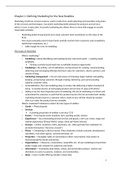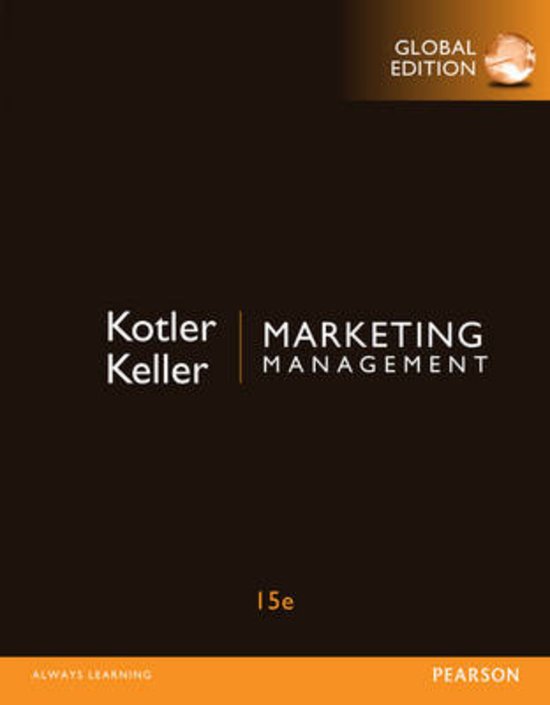Chapter 1: Defining Marketing for the New Realities
Marketing is both an art and a science, and it results from careful planning and execution using state-
of-the-art tools and techniques. Successful marketing builds demand for products and services,
which, in turn, creates jobs. Successful marketing also allows firms to more fully engage in socially
responsible activities.
- Marketing builds strong brands and a loyal customer base (contributes to the value of the
firm).
- First must constantly move forward (and carefully monitor their customers and competitors,
satisfy their employees, etc.)
o Little margin for error in marketing.
The Scope of Marketing
- What is marketing?
o Marketing is about identifying and meeting human and social needs -> meeting needs
profitably.
Turning a private/social need into a profitable business opportunity.
o Marketing is the activity, set of institutions, and processes for creating, communicating,
delivering and exchanging offerings that have value for customers, clients, partners, and
society at large.
o Marketing management -> the art and science of choosing target markets and getting,
keeping, and growing customers through creating, delivering, and communicating
superior customer value.
o Social definition, the role marketing plays in society: like delivering a higher standard of
living. “A societal process of exchanging product and services of value with others”.
o Selling is not the most important part of marketing; the aim of marketing is to know and
understand the customer so well that the product/service fits him and sells itself. Ideally,
marketing should result in a customer who is ready to buy. All that should be needed
then is to make the product/service available.
- What is marketed? Marketers market 10 main types of entities:
o Goods -> Physical goods
o Services
A growing proportion of entities is services (2/3)
o Events -> Time-based events (markets, fairs, sporting events, shows)
o Experiences -> By orchestrating several services and goods, a firm can create, stage and
market experiences (Disney World, camps, climb up Mount Everest).
o Persons -> Artists, musicians, CEOs, physicians, etc. often get help from marketers to
promote themselves (“become a brand”).
o Places -> Competing to attract tourists. Place marketers include economic development
specialists, real estate agents, commercial banks, etc.
o Properties -> Intangible rights of ownership to either real property (real estate) or
financial property (stocks and bonds).
o Organizations -> Museums, corporations, nonprofits, etc. all use marketing to boost their
public images and compete for audiences and funds.
o Information -> Essentially what books, school, and universities produce, market and
distribute at a price to parents, students, and communities.
o Ideas -> Every market offering includes a basic idea.
1
, “In the factory we make cosmetics; in the drugstore we sell hope”
Products and services are platforms for delivering some idea or benefit.
Social marketers promote ideas like “friends don’t let friends drive drunk”.
- Who Markets?
o A marketer is someone who seeks a response (attention, purchase, vote, donation) from
another party, called the prospect. If two parties are seeking to sell something to each
other, we call them both marketers.
o Marketers do not only stimulate demand for their products, they also seek to influence
the level, timing, and composition of demand to meet the objectives.
o 8 Possible demand states:
Negative demand – Consumers dislike the product and may even pay to avoid it.
Nonexistent demand – Consumers may be unaware of or uninterest in the product.
Latent demand – Consumers may share a strong need that cannot be satisfied by an
existing product.
Declining demand – Consumers begin to buy the product less frequently or not at
all.
Irregular demand – Consumer purchases vary on a seasonal, monthly, weekly, daily
or even hourly basis.
Full demand – Consumers are adequately buying all products put into the
marketplace.
Overfull demand – More consumers would like to buy the product than can be
satisfied.
Unwholesome demand – Consumers may be attracted to products that have
undesirable social consequences.
o In each case, marketers must identify the underlying cause(s) of the demand state and
determine a plan of action to shift demand to a more desired state.
o Market -> A
collection of buyers
and sellers who transact over a particular product or product class.
o Marketers view sellers as the industry and use the term market to describe customer
groups. They talk about need markets, product markets, demographic markets,
geographic markets, labor markets, etc.
o Key Customer Markets:
Consumer markets: Companies selling mass consumer goods/services establish a
strong brand image by developing a superior product/service, ensuring its
availability, and backing it with engaging communications and reliable performance.
2
, Business markets: Companies selling business goods/services often face well-
informed professional buyers. Advertising and web sites can play a role, but the
sales force, price, and seller’s reputation may play a great one.
Global markets: Companies in the global marketplace navigate cultural, language,
legal, and political differences while deciding which countries to enter, how to enter,
how to adapt product features and how to set prices and communicate.
Nonprofit and governmental markets: Companies selling to nonprofit organizations
with limited purchasing power (churches, universities) need to price carefully.
Buyers often focus on practical solutions and favor the lowest bid.
Core Marketing Concepts
- Needs -> The basic human requirements (air, food, water, clothing, shelter, recreation,
education, entertainment). Five types:
o Stated needs (The customer wants an inexpensive car)
o Real needs (The customer wants a car whose operating cost, not initial price, is low)
o Unstated needs (The customer expects good service from the dealer)
o Delight needs (The customer would like the dealer to include an GPS system)
o Secret needs (The customer wants friends to see him as a savvy consumer)
- Wants -> Needs become wants when directed to specific objects that might satisfy the need.
o Our wants are shaped by our society (culture, et cetera).
- Demands -> Wants for specific products backed by an ability to pay.
- Marketers do not create needs: Marketers might promote the idea that a Mercedes satisfies
a person’s need for social status. They do not, however, create the need for social status. To
gain an edge, companies must help customers learn what they want.
- Markets identify different segments of buyer by identifying differences. Then they decide
which segments present the greatest opportunity and develop a market offering for each of
the target markets that it positions in target buyers’ minds as delivering some key benefit(s).
- Companies address customer needs by putting forth a value proposition (= a set of benefits
that satisfy those needs = intangible). This is made physical by an offering (can be
combination of entities). A brand is an offering from a known source.
- To reach a target market, the marketer uses three kinds of marketing channels:
o Communication channels deliver and receive messages from target buyers and includes
media, appearance, etc.
o Distribution channels help display, sell, or deliver the physical product/service. This can
be direct via internet, mail, etc. or indirect with distributors, wholesalers, etc.
o Service channels are used to carry out transactions with potential buyers (warehouses,
transportation, insurance companies, banks).
- Three categories of communication options:
o Paid media include TV, magazine and display ads, paid search, etc.
o Owned media are communication channels marketers actually own, like a
company/brand brochure, web site, blog, Facebook page, etc.
o Earned media are streams in which consumers, the press or other outsiders voluntarily
communicate something about the brand via word of mouth, etc.
- Marketers now think of three “screens” or means to reach consumers: TV, Internet, and
mobile. Watching TV did not become much less, as people often watch two screens.
o Impressions occur when consumers view a communication, are a useful metric for
tracking the scope or breadth of a communication’s reach (not any insight on the results).
3
, o Engagement is the extent of a customer’s attention and active involvement with a
communication. It reflects a more active response (for example Facebook likes,
comments, sharing, etc.). Engagement can extend to personal experiences that
transform a firm’s products/services.
- Value -> The sum of the tangible and intangible benefits and costs.
o Primarily a combination of quality, service and price (QSP), called the customer value
triad.
- Satisfaction reflects a person’s judgment of a product’s perceived performance in
relationship to expectations. If performance falls short of expectations, the customer is
disappointed. If it matches expectations, the customer is satisfied. If it exceeds them, the
customer is delighted.
- Supply chain -> A channel stretching from raw materials to components to finished products
carried to final buyers. Each company in the chain captures only a certain percentage of the
total value generated. When a company acquires competitors or expands
upstream/downstream, it aims to capture a higher percentage of the supply chain value.
- Competition -> Includes all the actual and potential rival offerings and substitutes a buyer
might consider.
- Marketing environment -> Consists of the task environment and the broad environment. The
task environment includes the actors engaged in producing, distributing and promoting the
offering. The broad environment consists of six components: demographic, economic, social-
cultural, natural, technological and political-legal environment. Marketers must pay close
attention to the trends and adjust their marketing strategies as needed.
The New Marketing Realities (Changes)
- Technology. The pace of change and the scale of technological achievement can be
staggering. Huge amounts of information and data are now available to consumers and
marketers. Brand marketers must enhance their “digital balance sheet”.
o Sharing information is power
o Even traditional marketing activities are affected by technology.
- Globalization. The world has become a smaller place. New transportation, shipping, and
communication technologies have made it easier for us to know the rest of the world, to
travel, to buy and sell anywhere.
o Globalization changes innovation and product development as companies take ideas and
lessons from one country and apply them to another.
o Globalization has made countries increasing multicultural, causing growth for some
minority groups (in the U.S.).
- Social responsibility. Poverty, pollution, water shortages, climate change, wars, and wealth
concentration demand our attention. The private sector is taking some responsibility for
improving living conditions, and firms all over the world have elevated the role of corporate
social responsibility.
o Marketing should also consider these things, as their effects extends to society.
o The organization’s task is thus to determine the needs, wants, and interests of target
markets and satisfy them more effectively and efficiently than competitors while
preserving or enhancing consumers’ and society’s long-term well-being.
This way companies can differentiate themselves from competitors.
- Big data: Big data is high-volume, high-velocity, and high-variety.
A Dramatically Changed Marketplace
4






